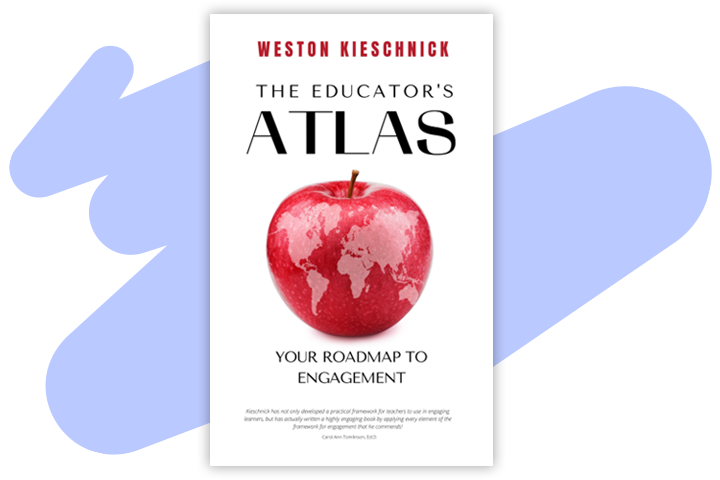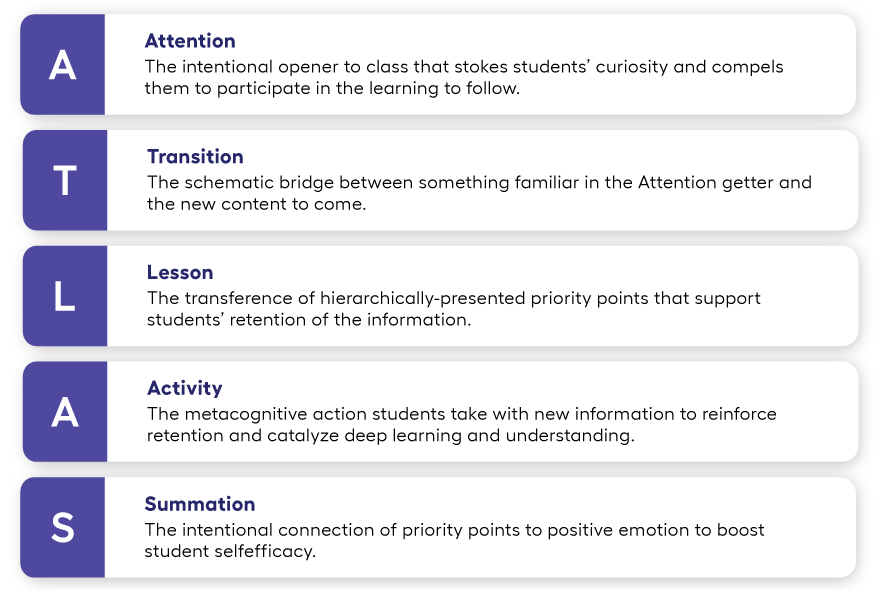The layering of emotion with the arc of a lesson was the most surprising thing about the book. You’re not just talking about what’s happening cognitively for kids. You’re talking about how they feel throughout the lesson and how that impacts their learning.
It’s profoundly impactful. Learning is sticky when it’s tied to emotion. If you just try to recall your profoundly memorable experiences, they’re all tied to intense emotions — when we felt joyful, when we felt sad, when we felt grief, when we felt surprised, like those things are memorable. Let’s capitalize on that… not ignore it.
You write that the ATLAS method, “Puts teachers in the driver’s seat.” Tell us what that means.
I have always been and will always be a firm believer that the single greatest thing that we can give children is a relationship with a highly qualified teacher who believes with relentless tenacity in their ability to succeed. I think one of the things that we need to do as a collective, both inside and outside education, is seek out ways to empower our teachers.
The ATLAS model puts them first because it recognizes that you can’t outsource engagement to a thing. No matter what it is, no matter what the technology tool, no matter what the product, it will never be as valuable at engaging kids as a really great teacher.
If an engaging teacher is the answer, if it’s the antidote to the problem of disengagement… then we have to help our teachers understand how to be more engaging. ATLAS is a support for the problem of engagement.
One of the more provocative things you write in ATLAS is, “Long live the lecture.” I thought we were supposed to be done with the whole “sage on the stage” thing.
Hell yeah! Long live the lecture. I stand by that statement.
Here’s the thing. Anyone who’s seen a really great TED talk, anyone who’s a church-going person and sees a really great sermon… there’s something profoundly moving about that experience. We like it. We like it when it’s done well and when it is a part of a larger catalog of experiences.
I am pro blended learning. I am pro collaborative learning. And at the same time, that doesn’t mean that the pendulum needs to swing so far that we leave lecture behind completely. Every single one of these things has a place. A person who can give a really great lecture or a really great speech—that person is excruciatingly valuable. We’ve all seen them when they’re garbage, and we’ve all seen ’em when they’re really good. And when they’re really good, there’s profound resonance in that. There’s something about it that rings the tuning fork deep down inside of us.
But a lot of educators will tell you they’re good at lectures, and guess how many for whom that’s actually true? A very, very small percentage. We have to take an honest look and ask ourselves, is this a thing I’m actually good at?
In your earlier book, Bold School, you talk about technology in education. Where do you think the future of edtech is headed now that we’re back in the classroom with all those devices from the pandemic?
When you’re looking at technology and whether it has value in the classroom, it has to do two things. It has to first improve efficacy—improve the quality of what’s happening in your classroom.
Second, it has to improve efficiency. This is the one that gets ignored. We often say, ‘We need to use this tool because this will make us better.’ Well, is this going to add hours upon hours of planning time to an already packed schedule? Because if that’s the case, there’s not a snowball’s chance in hell I’m using any of this technology. It’s why so many teachers have resisted and continue to resist.
What about blended learning? Where is that trend headed?
Honestly, I think I’m done saying “blended learning.”
I remember when Jurassic Park came out, it was a profound experience because they were using CGI in a way that had never been done before. Other movies started to use CGI in that way, but nobody distinguished the difference between a CGI movie and one that is not. You know what they all were? Just movies. It’s this weird thing that we’ve done in education where we’re just like, oh, if there’s technology involved, this is blended learning. But if there’s no technology involved, this is just regular teaching and learning.
I think any good teaching and learning that happens from this moment forward is going to include elements of technology.
I cannot tell you the number of ‘Tech Tuesdays’ I’ve seen in schools around the country because teachers have been encouraged to use technology. You can trace that back to how we talk about blended learning as though it’s a separate thing, and it’s just not. It’s just great teaching.


